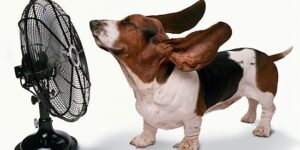
Whether we’re going for a run or lounging at the beach on a sweltering summer afternoon, the human body will respond by producing sweat to keep us cool. Although our dogs experience the heat and humidity of summer just as we do, they unfortunately don’t have the same natural mechanism to lower their body temperatures — which is why we humans have to be especially vigilant about keeping our pets cool this summer season. So, do dogs sweat, and if dogs do sweat, how do dogs sweat?
So, how do dogs sweat exactly? Dogs have a few different types of sweat glands in their bodies. Merocrine glands are present in the paw pads on their feet, and serve as one of the primary ways to help cool their bodies. These glands will activate when the dog is hot or when they are stressed or anxious, which is why you may see or feel wet feet on dogs that are stressed or nervous.
Dogs also have apocrine sweat glands, which are located at every fur follicle throughout the body and release apocrine sweat on the fur. However, these glands do not function as a way to cool the animal. Dogs don’t exactly ‘sweat,’ as they lack the eccrine sweat glands over most of their bodies.
Then how do dogs sweat if it’s not similar to how humans sweat? Our dogs attempt to keep themselves cool through panting … which is pretty clear if you’ve ever seen a dog hanging out in the garden with his tongue dangling from his mouth. The most effective way for a human to cool off is to sweat by releasing moisture from the skin. But in dogs and cats, the most effective way to cool their bodies is to pant through rapid breathing. Dogs will start to pant when they’re overheated. The mouths will open very wide, and their tongues will hang out of the mouths.
How to Help Your Dog Stay Cool
A responsible pet parent’s question after, “How do dogs sweat?” is, “How do we cool dogs down?” When enjoying the outdoors with your pooch this summer, pet owners should be on the lookout for panting as one of the first indicators that your four-legged friend should head indoors. Damion, owner of Fetch Dog Walking & Training advises pet owners to completely avoid strenuous activities with their pets when the humidity is 80 percent or greater, as the high humidity negates the animal’s ability to effectively pant and cool themselves down.
You definitely want to keep pets indoors and only walk them during the cooler parts of the day. Brachycephalic breeds like Pugs and Shih Tzus should be especially cautious, as they suffer from airway issues and can thus overheat more easily.
Pet owners must also provide adequate rest periods to allow their dogs to recover from any activity, provide shade from the sun, and always ensure they have cool water to drink. And be aware of the conditions when taking your dog for a walk this summer; pet owners should always place their own hands on the tarmac to determine how hot the surface of the road is. If it’s uncomfortable to you, it’s definitely too hot for your pet’s paws.
Thinking about spraying your pet with the hose to cool her off? You may want to avoid using water from that garden hose that’s been sitting in the garden all day. Water sitting in the garden hose during periods of high heat can reach scalding temperatures and when applied to your pet, can burn her skin.
What to Do if Your Dog Becomes Overheated
Another question after,“How do dogs sweat?” is — what should you do if your dog gets overheated? In the unfortunate instance that your pet has become overheated, it can lead to dangerous conditions, like heat stroke in dogs. Your dog may have difficulty walking or standing, and she will be breathing rapidly and heavily. In severe cases, dogs may collapse suddenly, suffer seizures or start vomiting. Heat stroke is an emergency and immediate veterinary care is advised. It’s a very serious situation in pets … and can be fatal.
If you suspect that your pet has become overheated, you can attempt to rapidly lower your dog’s body temperature by placing fans on her, bringing her into an air-conditioned car or room, or placing cool, wet towels at the groin and between the front legs while they’re being transported to the nearest veterinarian. Just avoid using ice-cold water, as this can cause the blood vessels to constrict and actually worsen the condition.
If there’s time, you want to first cool your pet down, whether by spraying water on the body or applying ice packs to the sides of the neck, underarms, or groin … but then you need to get going to the vets immediately for treatment.
Stay safe out there in the heat everyone..Woof!
Damion

